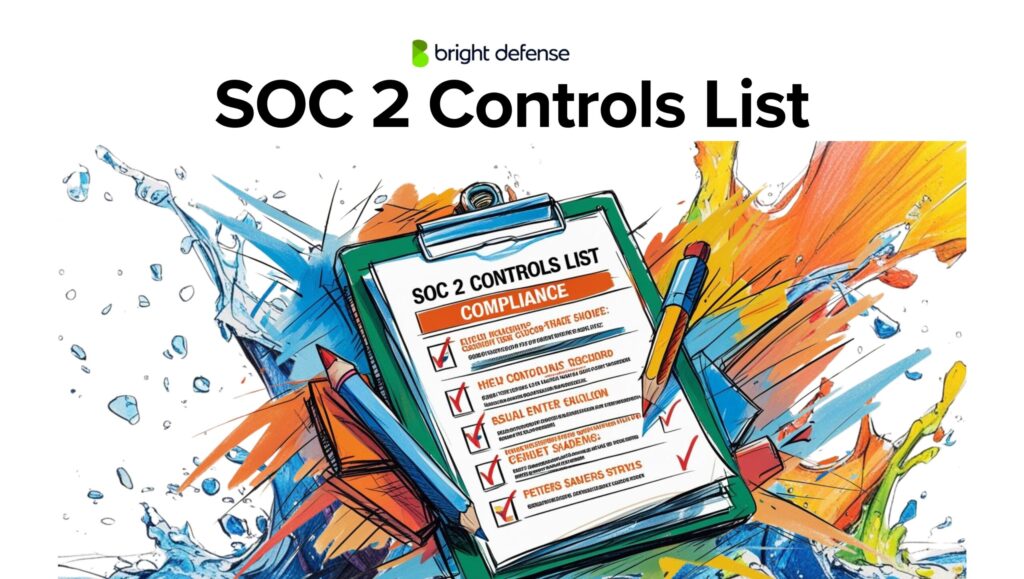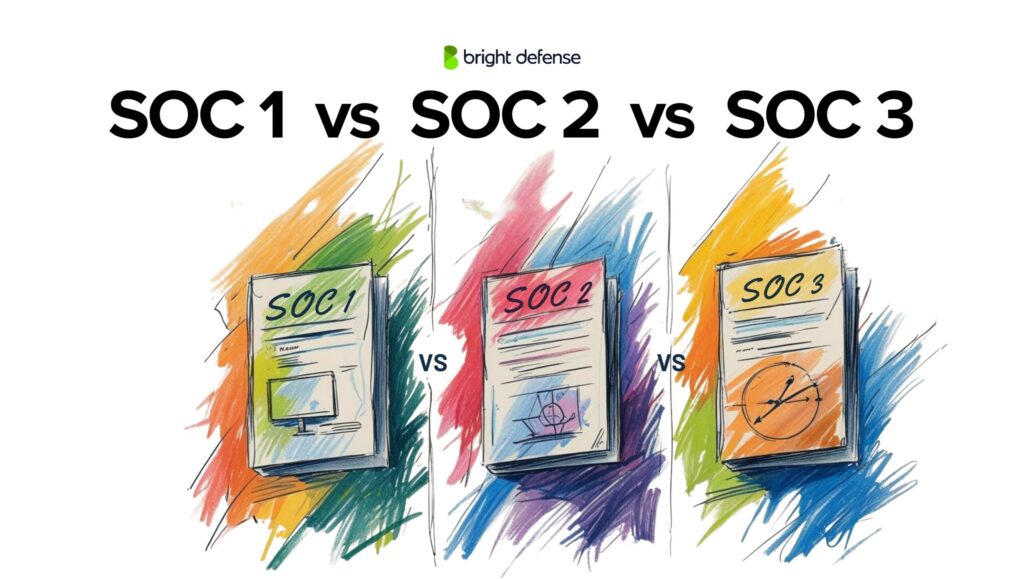
Tim Mektrakarn - CISSP | CISA | ISO 27001
June 30, 2025
SOC 2 Compliance Deep Dive
Unlock the potential of SOC 2 compliance to safeguard your customer data and boost your business’s credibility. SOC 2 compliance isn’t just a regulatory framework. It’s a commitment to maintaining the highest standards of data security and operational integrity. We’ll dive into SOC 2 compliance requirements in this article and discuss the Trust Service Criteria (TSC), which focuses on five key areas: security, availability, processing integrity, confidentiality, and privacy. Understanding these criteria is essential for any business handling sensitive customer information, as they guide how to manage data securely and responsibly.
Understanding SOC 2 Compliance
SOC 2, developed by the American Institute of Certified Public Accountants (AICPA), specifically targets service organizations that store customer data in the cloud. This makes it a critical standard for tech companies, SaaS providers, and any business relying on cloud storage and services. There are two types of SOC 2 reports: Type I and Type II. Type I evaluates the suitability of your controls at a specific point in time, while Type II assesses their effectiveness over a period, typically a minimum of six months. This distinction helps you understand not just the existence of controls but also their operational effectiveness over time.
The AICPA plays a pivotal role in this by setting the standards for SOC 2 compliance. These standards ensure that your business not only implements adequate protections but also adheres to ongoing best practices in data security. Implementing these standards isn’t just about compliance; it’s about building trust with your customers and establishing a reputation as a secure and reliable business partner.
The Five Trust Service Criteria (TSC)
Security in SOC 2
In the context of SOC 2 Type II compliance, the Security criterion is paramount and extensively scrutinized. This criterion is designed to protect against unauthorized access to and disclosure of information. Unlike SOC 2 Type I, which evaluates the design of controls at a specific point in time, Type II assesses how effectively these controls operate over a defined review period, usually at least six months. This continuous evaluation is crucial for businesses looking to demonstrate long-term reliability and security in their operations.

Definition and Scope of the Security Criterion
The Security criterion, often referred to as the Common Criteria, involves measures and policies that an organization implements to prevent, detect, and respond to incidents that could compromise the security of the system or the information it holds. The scope of this criterion includes but is not limited to:
- Physical security controls that prevent unauthorized physical access to facilities.
- Network and information security technologies that protect against unauthorized software, data, and user access.
- Processes that detect and mitigate security breaches such as real-time intrusion detection and ongoing monitoring.
Common Security Controls and Measures
Implementing robust security controls is essential to achieve and maintain SOC 2 Type II compliance. These controls are generally grouped into two categories: preventive and detective. Preventive controls are designed to stop unauthorized actions before they occur, while detective controls aim to identify and respond to security incidents after they have occurred. Common security controls include:
- Network Security: Firewalls, encryption, antivirus software, and secure socket layer (SSL) protocols.
- Access Controls: Role-based access control systems, multi-factor authentication, and biometric verification.
- Data Security: Data encryption both at rest and in transit, along with secure data deletion practices and data masking.
- Incident Response: Automated alerting systems, continuous monitoring, and an established incident response team.
Security SOC 2 Compliance Requirements
For SOC 2 Type II, the demonstration of operational effectiveness of these controls over time is critical. Examples of specific compliance requirements might include:
- Documentation of Security Policies: Clearly written and accessible policies that outline security measures, responsibilities, and protocols.
- Regular Security Training and Awareness Programs: Ensuring all employees are aware of security risks and how to prevent them.
- Log Collection and Analysis: Automated systems to log and analyze access and security events to detect potential security incidents.
- Periodic Reviews and Audits: Regularly scheduled audits of security controls to ensure they are functioning as intended and to identify areas for improvement.
The ongoing nature of these requirements under SOC 2 Type II mandates continuous vigilance and adaptation to emerging security threats. This not only protects the organization and its data but also reassures clients and partners of the organization’s commitment to maintaining a secure and trustworthy environment.
Is Penetration Testing a Requirement for SOC 2?
Penetration testing is not explicitly required for SOC 2 compliance. SOC 2 focuses on the design and operational effectiveness of security controls rather than specific technical tests. However, penetration testing supports the Trust Services Criteria for Security by helping demonstrate risk management and system monitoring efforts.
Although optional, many organizations perform penetration tests to strengthen their audit position and show proactive security practices. Auditors often view penetration testing results as strong evidence of effective controls.
For a detailed explanation, visit our blog:
👉 Is Penetration Testing a Requirement for SOC 2?
Availability in SOC 2 Compliance
Availability is a critical Trust Service Criterion under SOC 2, especially for Type II reports, where the focus is not just on the existence of controls but on their operational effectiveness over time. For businesses that rely on continuous service delivery, such as cloud service providers or SaaS companies, demonstrating strong availability controls is essential to maintaining trust and meeting customer expectations.
Defining Availability as it Relates to SOC 2
In the context of SOC 2, availability refers to the accessibility of the system, products, or services as stipulated by a contract or service level agreement (SLA). It’s not just about uptime; it also encompasses the performance levels and reliability of the services being provided. This criterion ensures that the system is operational and available for use as agreed upon with clients. The goal is to minimize downtime and maintain the performance needed for the successful operation of the system.
Key Components of Availability SOC 2 Compliance Requirements
Achieving availability in SOC 2 Type II requires a combination of proactive and reactive measures designed to ensure that services are accessible and functional at all times. Key components include:
- Network Performance Monitoring: Tools and procedures to continuously monitor and optimize network performance, ensuring accessibility and responsiveness.
- Disaster Recovery Plans: Comprehensive strategies and tools to recover from catastrophic events, ensuring continuity of operations with minimal disruption.
- Redundant Systems: Duplication of critical components or functions of a system within the same network to increase reliability and availability.
- Capacity Management: Regular assessment and scaling of resources to meet evolving demands without degrading performance.
Availability Examples of Metrics and Controls
For a SOC 2 Type II report, specific metrics and controls are vital for demonstrating the effective management of availability risks. Examples include:
- Uptime Percentage: SLAs typically include this common metric, which tracks the percentage of time services remain available and functional within a specific period.
- Failover Testing: Conduct regular tests on redundant systems to guarantee a smooth takeover in case of a primary system failure.
- Traffic Load Management: Employ tools and techniques to balance and manage the load on the system’s resources, preventing overloads that might cause downtime.
- Incident Management: Implement mechanisms to quickly address and mitigate failures. Use incident logs and response times as metrics to gauge the process’s responsiveness and effectiveness.
- Backup Procedures: Schedule and test backup processes regularly to ensure quick and accurate data restoration in the event of data loss or corruption.
Maintaining and documenting the effectiveness of these controls over the assessment period is crucial in a SOC 2 Type II audit. The focus on operational effectiveness helps reassure clients that the service provider is committed to maintaining high standards of availability, thus fostering trust and ensuring customer satisfaction. This ongoing monitoring and adaptation to changing conditions are what set SOC 2 Type II apart, highlighting a proactive approach to service and system management.

Confidentiality in SOC 2 Type II
Confidentiality is a key Trust Service Criterion under SOC 2, particularly critical in Type II reports where the focus extends to the effective management and protection of confidential information over time. This criterion ensures that data classified as confidential is protected from unauthorized access and disclosures throughout its lifecycle, from creation and storage to disposal.
The Role of Confidentiality in SOC 2
The role of confidentiality within SOC 2 compliance involves ensuring that sensitive information is accessible only to those who have authorization and a legitimate business need to know. This protection helps prevent the unauthorized disclosure of confidential data, thereby safeguarding the organization’s competitive edge, reputation, and legal compliance. For industries that handle sensitive financial records, intellectual property, personal customer data, or any other confidential information, robust confidentiality measures are non-negotiable.
Types of Data Considered Under Confidentiality
Confidential data can vary significantly depending on the industry and specific company policies. However, common types of data that are generally considered confidential include:
- Personal Identifiable Information (PII): Such as social security numbers, credit card information, and personal health information.
- Business Information: Such as trade secrets, financial forecasts, internal strategies, and other proprietary knowledge.
- Customer Data: Contracts, user data, and personal preferences that are sensitive in nature.
- Legal Documents: Information that is sensitive due to legal constraints or that could impact legal cases.
Encryption, Access Controls, and Other Safeguards
To effectively protect confidentiality, organizations must implement a range of safeguards that ensure only authorized access and prevent unauthorized disclosure:
- Encryption: Encrypt data both at rest and in transit to ensure that, even with unauthorized access, the information remains unintelligible without the correct decryption key.
- Access Controls: Implement robust access controls to restrict data access based on user roles and the principle of least privilege, including strong authentication measures to verify user identities before granting access.
- Data Masking and Redaction: Use techniques to obscure specific data within a database or file, ensuring sensitive information remains hidden during processing or reporting.
- Secure Auditing and Monitoring: Continuously monitor access and usage of confidential information to detect and respond to potential confidentiality policy violations.
- Physical Security: Maintain tight control and monitoring of physical access to systems that house confidential information.
- Training and Awareness: Regularly educating employees on the importance of confidentiality and how to handle sensitive information properly.
For SOC 2 Type II compliance, it is crucial not only to establish these safeguards but also to demonstrate their continuous effectiveness throughout the evaluation period. This involves regular testing and reviews to ensure the controls are adequate and functioning as intended, thereby maintaining the confidentiality of sensitive data effectively. This continuous oversight helps to build trust with clients and stakeholders, emphasizing the organization’s commitment to security and compliance.
Processing Integrity in SOC 2 Framework
Processing integrity criterion ensures that systems perform their functions free of errors, defects, and unauthorized manipulation, thereby delivering outputs that are complete, valid, accurate, timely, and authorized. This is crucial for businesses that process significant volumes of transactions or data where precision is critical, such as financial services, healthcare, and e-commerce platforms.
Importance of Processing Integrity in Data Handling
Processing integrity is essential to maintain the accuracy and reliability of the data processing operations within a system. It ensures that data is processed correctly, in a manner that is consistent with the organization’s objectives, and without unintended alterations or data loss. High processing integrity minimizes the risk of errors and data corruption, both of which can have significant repercussions, including financial losses, compliance violations, and damage to customer trust.
Controls That Ensure Complete and Accurate Data Processing
To achieve processing integrity, organizations need to implement a range of controls that address various aspects of data processing:
- Input Controls: Ensure that the data entered into a system is accurate and authorized. These may include validation checks, approvals for data input, and error detection processes.
- Processing Controls: Focus on the integrity of data throughout the processing stages. This includes maintaining transaction logs, implementing error detection and correction mechanisms during processing, and ensuring that processing tasks are performed in the correct sequence and are completed without interruption.
- Output Controls: Ensure that the data output from the system is accurate and appropriately formatted. These controls include reviewing output data for accuracy and completeness, maintaining secure transmission protocols, and ensuring only authorized users can access the output.
Measurement and Monitoring of Processing Integrity
Measuring and monitoring the effectiveness of processing integrity controls is a critical component of SOC 2 Type II compliance. Metrics and monitoring activities might include:
- Error Detection and Correction Reports: Regularly reviewing these reports to identify, log, and correct processing errors.
- Audit Trails: Maintaining comprehensive logs that record data processing activities, which can be reviewed to trace errors back to their source.
- Reconciliation Procedures: Regularly comparing data from different sources to verify that they are consistent and align with each other, thus ensuring data integrity across the system.
- System Performance Monitoring: Tracking system performance to detect any issues that could affect processing integrity, such as slow processing times or system crashes.
- Quality Assurance Testing: Regular testing of the system to ensure it meets the required standards of processing accuracy and functionality.
In SOC 2 Type II audits, it’s not enough to just have these controls in place; organizations must also demonstrate their effectiveness continuously over the audit period. This ongoing evaluation and adaptation are essential to ensuring that processing integrity is maintained and that any potential issues are addressed proactively, thus safeguarding the organization’s operations and its reputation.

Privacy in SOC 2 Compliance
Privacy stands as a critical Trust Service Criterion under SOC 2, particularly in Type II reports, which assess the continuous implementation and effectiveness of privacy controls over time. This criterion emphasizes the proper handling of personal information in line with the organization’s privacy policy and applicable laws and regulations. The aim is to collect, use, retain, disclose, and dispose of personal information in ways that respect individual privacy rights.
Understanding Privacy in the Context of SOC 2
Privacy in SOC 2 centers on the effective management of personal information, ensuring it aligns with the privacy notices and standards the organization has committed to. This encompasses adherence to privacy frameworks like GDPR, HIPAA, or others pertinent to the organization’s operations or geographic location. SOC 2 reports emphasize not only the controls that safeguard data security but also those that guarantee data is processed fairly, lawfully, and transparently.
Relationship Between Privacy and Personal Identifiable Information (PII)
Personal Identifiable Information (PII) is central to privacy considerations in SOC 2, serving as a key component of data that can identify an individual. This includes names, social security numbers, email addresses, and more. The relationship between privacy and PII is fundamental, necessitating that effective privacy controls are in place to ensure that PII is accessed and processed only by authorized personnel for legitimate purposes. Additionally, these controls must protect PII from unauthorized access, use, or disclosure.
Privacy SOC 2 Compliance Requirements
Implementing and maintaining robust privacy controls is essential for achieving SOC 2 Type II compliance. These controls must address several aspects of data privacy:
- Data Minimization: Limiting data collection to what is directly relevant and necessary to accomplish a specified purpose.
- Access Controls: Ensuring that access to personal data is restricted to authorized personnel who need access to perform their job functions.
- Consent Management: Obtaining and managing consent for the collection and use of personal data, including mechanisms to withdraw consent easily.
- Data Subject Rights: Implementing procedures to address data subject rights, such as access to data, correction, deletion, and the ability to object to data processing.
- Privacy Impact Assessments: Conducting assessments to identify and mitigate risks associated with data processing activities.
- Training and Awareness: Providing regular training to employees on privacy policies, the importance of protecting PII, and their specific responsibilities in maintaining privacy.
- Breach Notification Procedures: Establishing and following protocols to notify regulatory authorities and affected individuals in the event of a data breach.
For SOC 2 Type II, it is not enough to have these controls in place at a single point in time; organizations must demonstrate that these controls are consistently applied and effective throughout the review period. This continuous adherence helps ensure that personal data is handled in a manner that respects privacy and builds trust with clients, partners, and regulators, reinforcing the organization’s commitment to comprehensive data protection.

Steps to Achieve SOC 2 Compliance
Pre-assessment and Gap Analysis
Kick off your journey to SOC 2 compliance by conducting a thorough pre-assessment and gap analysis. This crucial step involves reviewing your current systems and controls against the SOC 2 compliance requirements. Identify areas where your security practices are strong and pinpoint gaps where improvements are necessary. This initial assessment sets the foundation for a tailored compliance strategy, ensuring you address specific needs effectively.
Selecting an Auditor and Planning the Audit
Choosing the right auditor is pivotal for achieving SOC 2 compliance. Look for a reputable and experienced auditor familiar with your industry. Once selected, collaborate with them to plan the audit meticulously. This includes setting timelines, defining the scope of the audit based on the SOC 2 compliance requirements, and understanding the documentation you need to provide. Proper planning with your auditor will streamline the process and reduce surprises.
Implementing Controls and Documenting Processes
Implement the necessary controls to meet SOC 2 compliance requirements. This involves enhancing your security measures, improving data handling procedures, and ensuring privacy controls are robust. Document every process and control in detail as this documentation is critical for the audit. Clear and comprehensive records demonstrate your commitment to compliance and make the audit process smoother.
Conducting the Audit and Addressing Issues
With preparations complete, undergo the SOC 2 audit. This will involve a thorough review of your controls, processes, and documentation to ensure they meet the stringent SOC 2 standards. Post-audit, address any issues or gaps the auditor identifies swiftly. Rectifying these issues not only brings you into compliance but also strengthens your systems against potential threats.
Common Challenges in Achieving SOC 2 Compliance
Resource Allocation and Cost
Allocating the necessary resources and managing the costs associated with achieving SOC 2 compliance can be challenging, especially for SMBs. Effective budgeting and resource management are key. Prioritize areas that need the most attention and allocate resources accordingly to maximize your investment in compliance.
Continuous Monitoring and Maintenance of Controls
SOC 2 compliance is not a one-time event but an ongoing commitment. Continuous monitoring and regular maintenance of controls are required to stay compliant. This can be demanding but is essential for maintaining the integrity and security of your systems.

Training Employees and Creating a Culture of Compliance
Creating a culture of compliance within your organization is crucial. Regularly train your employees on SOC 2 compliance requirements and best practices in data security and privacy. Engaged and informed employees are your best defense against breaches and non-compliance.
Benefits of SOC 2 Compliance
Enhanced Trust and Credibility with Clients
Achieving SOC 2 compliance significantly boosts your business’s credibility. Clients trust you more when they know you meet rigorous data protection standards, making it easier to retain existing clients and attract new ones.
Improved Data Security Practices
The process of meeting SOC 2 compliance requirements improves your data security practices. This not only helps in compliance but also in protecting your business from data breaches and cyber threats.
Competitive Advantage in the Marketplace
SOC 2 compliance can be a strong differentiator in the marketplace. It demonstrates your commitment to security and privacy, appealing to discerning clients and giving you a competitive edge.
For SMB owners, navigating the path to SOC 2 compliance might seem daunting, but the rewards—enhanced security, improved trust, and competitive advantage—make it a worthy investment. With the right approach and commitment, you can meet SOC 2 compliance requirements and turn them into a powerful tool for business growth and success.
About Bright Defense
As you consider the path toward SOC 2 compliance, Bright Defense is here to guide you every step of the way. Our continuous compliance services are specifically designed to help SMBs not only achieve but also maintain SOC 2 compliance with ease and efficiency.
Next Steps for Achieving SOC 2 Compliance:
- Assessment: Begin with an initial consultation to assess your current compliance status and identify what’s needed to bridge the gap to SOC 2 requirements.
- Standard Compliance Plans: Work with our team to develop a customized approach using our standard compliance plans that addresses your specific needs, resources, and business objectives.
- Implementation and Monitoring: Leverage our expertise to implement necessary controls and engage in continuous monitoring to ensure that you not only reach but sustain SOC 2 compliance.
- Ongoing Support: Take advantage of our ongoing support and guidance to adapt to any changes in compliance standards or business operations.
Connect with a Compliance Expert: Don’t navigate the complexities of SOC 2 compliance alone. Contact a Bright Defense compliance expert today to discuss how we can help you secure your systems and build trust with your clients through robust compliance practices. Our experts are ready to provide you with insights, support, and the tools needed to maintain compliance effectively and efficiently.
Act now and turn the challenge of compliance into an opportunity for growth with Bright Defense!
Get In Touch



